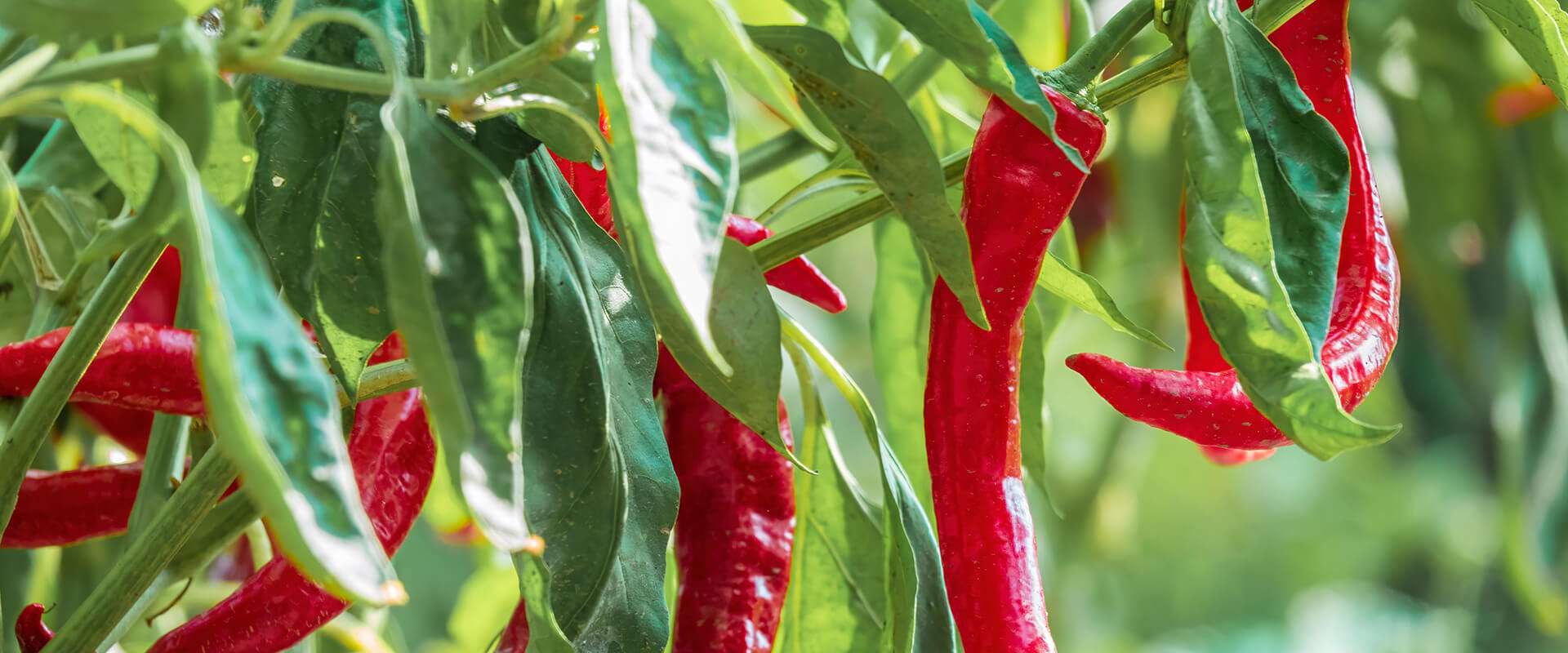
The Peppers
Exotic Peppers
An exotic pepper refers to pepper varieties that are less commonly available in mainstream markets and is often unfamiliar. These peppers may have unique flavors, appearances, or heat levels, and are typically used in specific cuisines or for specialized purposes.
Aji Jobito
Heat Profile: No Heat
Scoville Heat Index: 500-1,000
Flavor Notes: Sweet, citrusy, aromatic
Region of Origin: Venezuela
Class: Exotic Pepper
Pairs with: Fruit salads, desserts, mild salsas; pairs with white sangria or sparkling water
Texas Big Yellows
Heat Profile: Medium
Scoville Heat Index: 5,000-15,000
Flavor Notes: Mild heat, fruity, slightly tangy
Region of Origin: United States
Class: Exotic Pepper
Pairs with: Grilling, salads, stuffed peppers; pairs with citrusy IPA or margaritas
Texas Big Reds
Heat Profile: Medium
Scoville Heat Index: 10,000-25,000
Flavor Notes: Mild heat, slightly sweet
Region of Origin: United States
Class: Exotic Pepper
Pairs with: Tex-Mex dishes, fajitas, salsas; pairs with light beer or tequila-based cocktails
Aji Charapita
Heat Profile: Hot
Scoville Heat Index: 30,000-50,000
Flavor Notes: Fruity, floral, intense heat
Region of Origin: Peru
Class: Exotic Pepper
Pairs with: Seafood, ceviche, sauces; pairs with tropical juice-based cocktails or IPA beer
Red Habanero
Heat Profile: Hot
Scoville Heat Index: 100,000-350,000
Flavor Notes: Sweet, tropical, very hot
Region of Origin: Mexico, Cuba, Amazon basin
Class: Exotic Pepper
Pairs with: Hot sauces, grilled meats, spicy soups; pairs with wheat beer or fruity cocktails
Jamaican Yellow Scotch Bonnet
Heat Profile: Hot
Scoville Heat Index: 100,000-350,000
Flavor Notes: Fruity, tangy, citrusy
Region of Origin: Amazon Basin, Central and South America
Class: Exotic Pepper
Pairs with: Jerk chicken, Caribbean dishes, sauces; pairs with tropical fruit punches
Jamaican Red Scotch Bonnet
Heat Profile: Hot
Scoville Heat Index: 150,000-325,000
Flavor Notes: Fruity, slightly earthy, very hot
Region of Origin: Amazon basin, Central and South America
Class: Exotic Pepper
Pairs with: Hot sauces, grilled fish, spicy stews; pairs with coconut water or ginger beer
Guatemalan Habanero
Heat Profile: Super Hot
Scoville Heat Index: 200,000-300,000
Flavor Notes: Very hot, fruity, tangy
Region of Origin: Amazon basin, Guatemala
Class: Exotic Pepper
Pairs with: Salsas, spicy stews, jerk chicken; pairs with dark rum or mango-based drinks
Papa Dreadie Scotch Bonnet
Heat Profile: Super Hot
Scoville Heat Index: 200,000-300,000
Flavor Notes: Fruity, complex, slightly smoky
Region of Origin: Amazon basin, Central and South America
Class: Exotic Pepper
Pairs with: Caribbean cuisine, rice and peas, marinades; pairs with rum cocktails
Chocolate Habanero
Heat Profile: Super Hot
Scoville Heat Index: 300,000-425,000
Flavor Notes: Smoky, rich, slightly sweet
Region of Origin: Caribbean
Class: Exotic Pepper
Pairs with: BBQ, mole sauces, chili; pairs with stout beer or spiced rum
Yellow Ghost
Heat Profile: Super Hot
Scoville Heat Index: 800,000-1,000,000
Flavor Notes: Fiery heat, citrusy, slightly fruity
Region of Origin: India
Class: Exotic Pepper
Pairs with: Spicy curries, chili, marinades; pairs with lassi or sweet mango drinks
Red Ghost
Heat Profile: Super Hot
Scoville Heat Index: 800,000-1,041,427
Flavor Notes: Intense heat, slightly smoky
Region of Origin: India
Class: Exotic Pepper
Pairs with: Hot sauces, extreme heat challenges, curries; pairs with milk-based drinks
Dorset Nagas
Heat Profile: Super Hot
Scoville Heat Index: 1,000,000-1,598,227
Flavor Notes: Fruity, floral, searing heat
Region of Origin: India, Bangladesh, United Kingdom
Class: Exotic Pepper
Pairs with: Curry, chutneys, extreme heat dishes; pairs with yogurt drinks or iced tea
Carolina Reapers
Heat Profile: Super Hot
Scoville Heat Index: 1,641,183-2,200,000
Flavor Notes: Extremely hot, sweet, citrusy
Region of Origin: United States by Ed Currie
Class: Exotic Pepper
Pairs with: Extreme hot sauces, spicy wings, BBQ; pairs with milk or creamy mango lassi
Non-Exotic Peppers
A non-exotic pepper refers to a variety of peppers that are commonly found in local grocery stores, widely distributed, and familiar. These peppers are typically used in everyday cooking and have a flavor profile that suits a broad range of dishes.
Yellow Bell
Heat Profile: No Heat
Scoville Heat Index: 0-100
Flavor Notes: Sweet, crisp, mild
Region of Origin: Central and South America
Class: Non-exotic Pepper
Pairs with: Salads, stir-fries, grilled dishes; pairs well with white wine or light citrusy drinks
Corno di Toro
Heat Profile: No Heat
Scoville Heat Index: 100-500
Flavor Notes: Sweet, mild, tender flesh
Region of Origin: Italy
Class: Non-exotic Pepper
Pairs with: Roasting, grilling, pasta dishes; pairs with Pinot Grigio or light beer
Jalapeno
Heat Profile: Mild
Scoville Heat Index: 2,500-8,000
Flavor Notes: Mild to medium heat, grassy, slightly sweet
Region of Origin: Mexico
Class: Non-exotic Pepper
Pairs with: Nachos, tacos, salsas; pairs with lagers or margaritas
Fresno
Heat Profile: Medium
Scoville Heat Index: 2,500-10,000
Flavor Notes: Slightly smoky, bright, fruity
Country of Origin: United States by Clarence Brown Hamlin
Class: Non-exotic Pepper
Pairs with: Ceviche, soups, hot sauces; pairs with pilsners or tropical cocktails
